
Bread is a staple food prepared from a dough of flour and water, usually by baking. Throughout recorded history and around the world, it has been an important part of many cultures' diet. It is one of the oldest human-made foods, having been of significance since the dawn of agriculture, and plays an essential role in both religious rituals and secular culture.
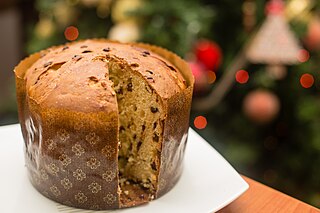
Panettone is an Italian type of sweet bread and fruitcake, originally from Milan, Italy, usually prepared and enjoyed for Christmas and New Year in Western, Southern, and Southeastern Europe, as well as in South America, Eritrea, Australia, the United States, and Canada.

Sourdough or sourdough bread is a bread made by the fermentation of dough using wild lactobacillaceae and yeast. Lactic acid from fermentation imparts a sour taste and improves keeping qualities.
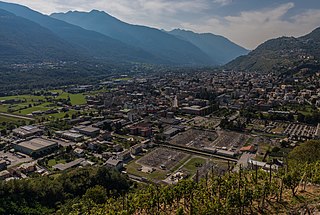
Sondrio is an Italian city, comune and administrative centre for the province of Sondrio, located in the heart of the Valtellina. As of 2015, Sondrio counted approximately 21,876 inhabitants. In 2007, Sondrio was named the Alpine Town of the Year.

Dough is a thick, malleable, sometimes elastic paste made from grains or from leguminous or chestnut crops. Dough is typically made by mixing flour with a small amount of water or other liquid and sometimes includes yeast or other leavening agents, as well as ingredients such as fats or flavorings.

Pandoro is an Italian sweet bread, most popular around Christmas and New Year. Typically a product of the city of Verona, pandoro traditionally has an eight-pointed shape.

Rugbrød is a very common form of rye bread from Denmark. Rugbrød usually resembles a long brown extruded rectangle, no more than 12 cm (4.7 in) high, and 30 to 35 cm long, depending on the bread pan in which it is baked. The basic ingredient is rye flour which will produce a plain or "old-fashioned" bread of uniform, somewhat heavy structure, but the most popular versions today contain whole grains and often other seeds such as sunflower seeds, linseeds or pumpkin seeds. Most Danes eat rugbrød every day.

A bread making machine or breadmaker is a home appliance for baking bread. It consists of a bread pan, at the bottom of which are one or more built-in paddles, mounted in the center of a small special-purpose oven. The machine is usually controlled by a built-in computer using settings input via a control panel. Most bread machines have different cycles for different kinds of dough—including white bread, whole grain, European-style, and dough-only. Many also have a timer to allow the bread machine to function without operator input, and some high-end models allow the user to program a custom cycle.

In many European countries, particularly in Central and Eastern Europe, there are various traditions surrounding the use of bread during the Easter holidays. Traditionally the practice of eating Easter bread or sweetened "communion" bread traces its origin back to Byzantium, Eastern Catholicism and the Orthodox Christian church. The recipe for sweetened or "honey-leavened" bread may date back as far as the Homeric Greek period based on anecdotal evidence from classical texts.

A ferment is a fermentation starter used in indirect methods of bread making. It may also be called mother dough.

Italian cuisine is a Mediterranean cuisine consisting of the ingredients, recipes, and cooking techniques developed in Italy since Roman times and later spread around the world together with waves of Italian diaspora. Significant changes occurred with the colonization of the Americas and the introduction of potatoes, tomatoes, capsicums, maize, and sugar beet—the latter introduced in quantity in the 18th century. It is one of the best-known and most appreciated gastronomies worldwide.
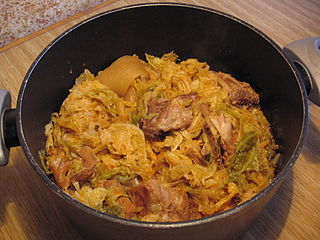
Lombard cuisine is the style of cooking in the Northern Italian region of Lombardy. The historical events of its provinces and of the diversity of its territories resulted in a varied culinary tradition. First courses in Lombard cuisine range from risottos to soups and stuffed pasta, and a large choice of second course meat or fish dishes, due to the many lakes and rivers of Lombardy.

The pizza di Pasqua, in some areas also called crescia di Pasqua, torta di Pasqua, torta al formaggio or crescia brusca, is a leavened savory cake typical of many areas of central Italy based on wheat flour, eggs, pecorino and Parmesan. Traditionally served at breakfast on Easter morning, or as an appetizer during Easter lunch, it is accompanied by blessed boiled eggs, ciauscolo and red wine or, again, served at the Easter Monday picnic. Having the same shape as panettone, the pizza di Pasqua with cheese is a typical product of the Marche region, but also Umbrian. There is also a sweet variant. The peculiarity of this product is its shape, given by the particular mold in which it is leavened and then baked in the oven: originally in earthenware, today in aluminum, it has a flared shape.

Christmas in Italy begins on 8 December, with the Feast of the Immaculate Conception, the day on which traditionally the Christmas tree is mounted and ends on 6 January, of the following year with the Epiphany, and in some areas female puppets are burned on a pyre, to symbolize, along with the end of the Christmas period, the death of the old year and the beginning of a new one. 26 December, is also a public holiday in Italy. The Italian term Natale derives from the Latin natalis, which literally means 'birth', and the greetings in Italian are buon Natale and felice Natale.

The cuisine of Basilicata, or Lucanian cuisine, is the cuisine of the Basilicata region of Italy. It is mainly based on the use of pork and sheep meat, legumes, cereals and vegetables, with the addition of aromas such as hot peppers, powdered raw peppers and horseradish. The local gastronomy is, for historical-cultural reasons, typically peasant, based on simple recipes and on the culture of reuse, in particular of meat and bread.

Veneziana is a sweet of the Lombard cuisine covered with sugar grains or almond icing. It is served in two versions: the bigger one is consumed during Christmas, like panettone; the smaller one is eaten as breakfast, along with cappuccino, like croissants. Veneziana is butter and flour-based and uses sourdough as leavening; the smaller version is usually plain, sometimes filled with custard, while the bigger version contains candied orange.
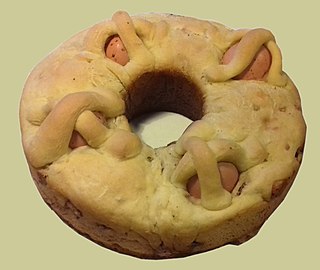
Casatiello is a leavened savory bread originating from Naples prepared during the Easter period.
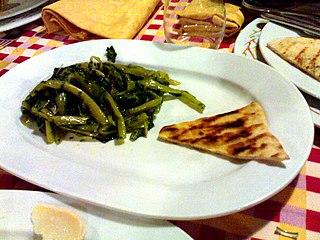
Crescia is a thin Italian flatbread typically prepared in Marche and Umbria. The crescia probably has a common ancestry to the piadina, to be found in the bread used by the Byzantine army, stationed for centuries in Romagna, in the north of the Marche (Pentapolis), and in the Umbrian Valley crossed by the Via Flaminia. The food is also known by the common name of "white pizza".
Patacucci, also known as zavardoni or giugetti, are a traditional type of fresh pasta from the provinces of Rimini, Forlì-Cesena, and Ravenna, consisting of squares or diamonds of rather irregular shape, obtained from a thick dough, prepared with water, wheat flour, corn flour, and salt.

Easter in Italy is one of the country's major holidays. Easter in Italy enters Holy Week with Palm Sunday, Maundy Thursday, Good Friday and Holy Saturday, concluding with Easter Day and Easter Monday. Each day has a special significance. The Holy Weeks worthy of note in Italy are the Holy Week in Barcellona Pozzo di Gotto and the Holy Week in Ruvo di Puglia.


















